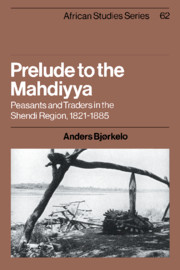Book contents
- Frontmatter
- Contents
- Figures
- List of maps
- List of tables
- Preface
- Acknowledgements
- Abbreviations
- Weights and measures
- The Sudan in the nineteenth century
- Introduction
- 1 The Ja'alī Kingdom of Shendi and its destruction
- 2 Shendi's economy on the eve of the Turkiyya
- 3 The Ja'aliyyīn under Turkish administration
- 4 The transformation of agriculture
- 5 Taxation
- 6 The transformation of commerce
- 7 Conclusion: dispersion and return
- Appendix: Three contracts from the archive of 'Abd Allāh Bey Ḥamza
- Notes
- Sources and bibliography
- Index
- OTHER BOOKS IN THE SERIES
3 - The Ja'aliyyīn under Turkish administration
Published online by Cambridge University Press: 31 October 2009
- Frontmatter
- Contents
- Figures
- List of maps
- List of tables
- Preface
- Acknowledgements
- Abbreviations
- Weights and measures
- The Sudan in the nineteenth century
- Introduction
- 1 The Ja'alī Kingdom of Shendi and its destruction
- 2 Shendi's economy on the eve of the Turkiyya
- 3 The Ja'aliyyīn under Turkish administration
- 4 The transformation of agriculture
- 5 Taxation
- 6 The transformation of commerce
- 7 Conclusion: dispersion and return
- Appendix: Three contracts from the archive of 'Abd Allāh Bey Ḥamza
- Notes
- Sources and bibliography
- Index
- OTHER BOOKS IN THE SERIES
Summary
The imposition of foreign rule set in motion profound changes throughout Sudanese societies and cultures. Before it came to an end it had brought under a single administration for the first time a vast area and numerous ethnic groups, languages and religions. The dārs of the Nile Valley and the savannas had been used to the often loose overlordship of the Funj and the 'Abdallāb. The Turks, however, introduced a quite new concept of government, derived from the Ottoman system of administration. They had come to rule as colonisers, to command obedience, to regulate the affairs of everyone at every level, and claimed a natural right to extract a surplus for the Egyptian treasury.
The term ‘Turk’ is used here in the colloquial Sudanese sense, as a label for all whom they considered to be connected with the hakūma or ‘government’. This is, of course, misleading as an ethnic label, as is also the term ‘Turco-Egyptian’;, so often used by historians. The foreign rulers consisted of a variety of ethnic elements, such as Greeks, Kurds, Albanians, ethnic Turks, Egyptians, Circassians (some of whom were or had been Mamluks i.e. slaves) and others. Turkish rather than Arabic was their language, and although the Viceroy in Cairo liked to think of the Sudan as Egypt's own possession, the Sudanese saw their new masters as representatives of the Ottoman empire as well as of the great Pasha in Cairo. In one sense the term ‘Ottoman’ would therefore provide a better description of the rulers.
- Type
- Chapter
- Information
- Prelude to the MahdiyyaPeasants and Traders in the Shendi Region, 1821–1885, pp. 34 - 52Publisher: Cambridge University PressPrint publication year: 1989

